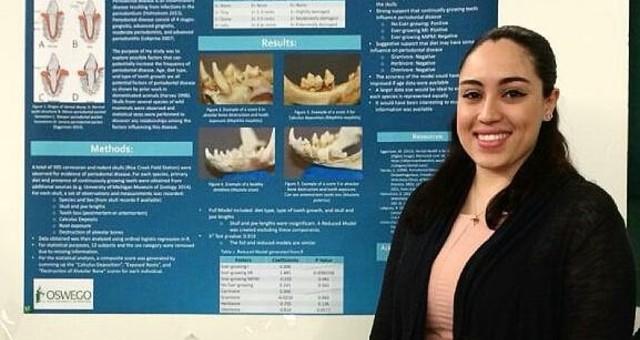Spring 2016
Evidence of periodontal disease in skulls of carnivorans and rodents
Periodontal disease is prevalent in humans and domesticated animals, such as cats and dogs. The purpose of my study was to explore possible factors that can potentially increase the frequency of periodontal disease. I focused on a variety of wild carnivorans and rodents where less is known about periodontal disease compared to domesticated dogs and cats. Age, diet type, and tooth type were all potential factors of periodontal disease that was observed and examined from observations made from skulls remains of several species of rodents and carnivorans. Statistical analysis was performed to discover any relationships among the factors of this disease.
The main thing I learned about conducting research is that it takes a lot of commitment and endurance to work on and stay committed such an extensive assignment. Being a two year long commitment, this is the most time I have ever spent working on a project. I went through the stress and confusion of how to begin my research. I went through the difficulties of data collection, and having to change my research approach after working on it for three semesters. However, my drive and motivation kept me going. Though stressful, this was an experience worth going through as it challenged me in a way that I had never been challenged before.
The most memorable research experience at Rice Creek Field Station was when I looked through the carnivoran and rodent skulls. I got to observe the differences in tooth growth, such as ever-growing or not and tooth type. Furthermore, it was interesting seeing the differences in the dentitions between the rodents and the carnivores. My favorite moment was when I was analysis the skunk (Mephitis mephitis) skulls. Two of the worst looking skulls, in terms of periodontium destruction, were skunk skulls. So it was really cool to see how bad the bone can be destroyed, exposing massive amounts of tooth roots.
I was born and raised in the Bronx. As a child my mother took me frequently to zoos to show me the importance of animals and further develop my love for them. In addition, I spent most of my time as a child watching animal documentaries and shows, especially ones that involved my childhood idol Steve Irwin. With these influences, I was drawn to the biological world. In elementary and high school, sciences classes were always the most enjoyable classes to me because I was able to enhance my knowledge about the world on a much deeper, scientific level.
Ever since I was a child, I have always been interested in animals. I grew up surrounded by animals: dogs, cats, reptiles, amphibians, small mammals, and birds. At the age of ten, my desire to become a veterinarian was set in stone when I had to care for an abused dog. I chose to attend SUNY Oswego because of the Zoology degree program offered. After I graduate in May 2016, I plan to gain more experience with animals by working in an animal hospital. At the same time, I plan to work on veterinary school applications and start vet school within the next two years.



